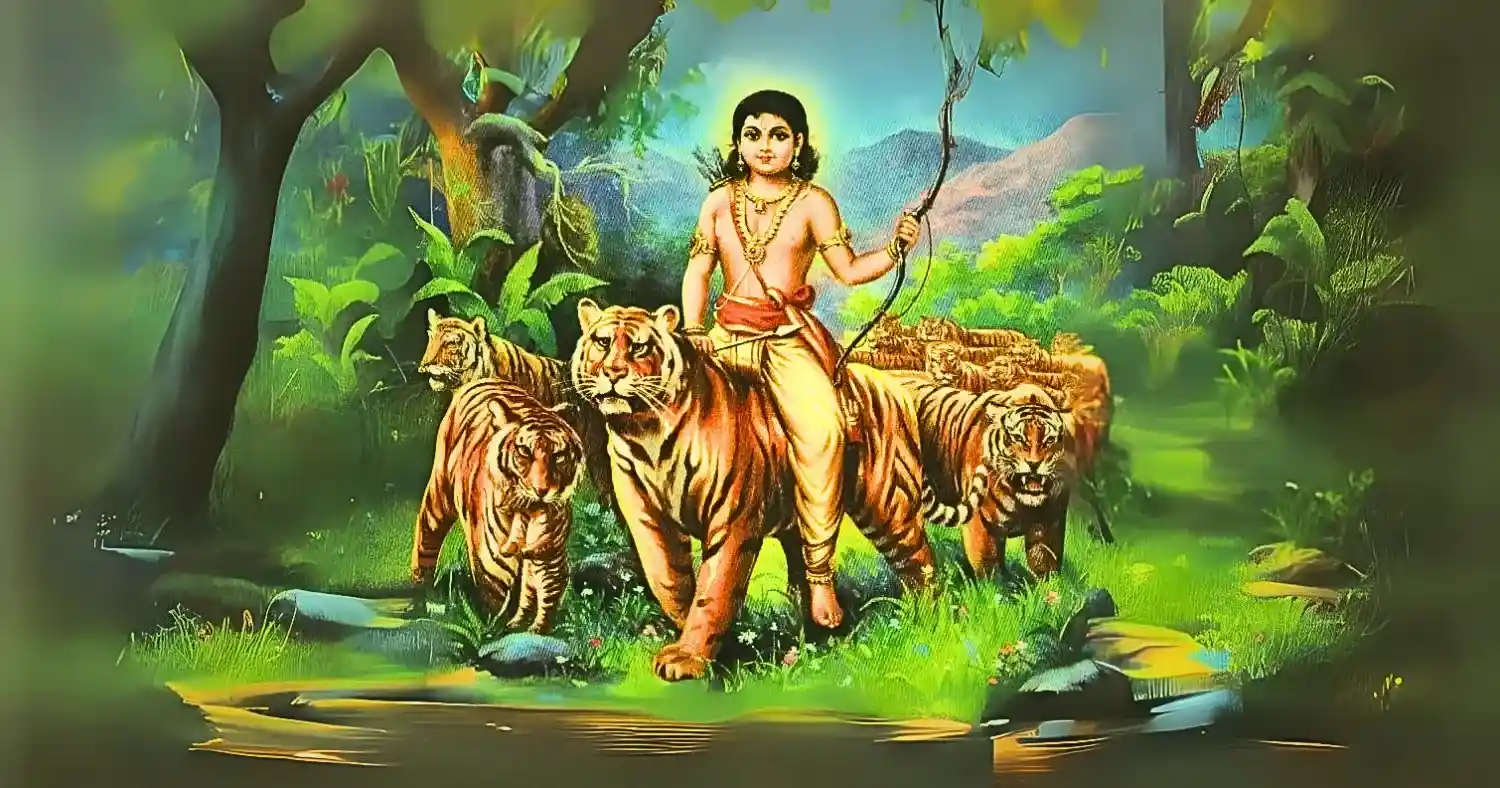Table of Contents
Sri Ayyappa Swami is the celibate warrior deity who is a powerful form of Dharma in the sacred land of Bharata. He is worshipped predominantly in Kerala and Tamil Nadu, Lord Ayyappa is the eternal symbol of unity, spiritual discipline, and divine balance. The mantra associated with Him is the clarion call Swamiye Sharanam Ayyappa” (സ്വാമിയേ ശരണം അയ്യപ്പ). This mantra is not merely a chant but a profound call to surrender oneself to the supreme protector and guide.
The Ayyappa Mantra is a powerful and sacred chant dedicated to Lord Ayyappa. He is revered for his purity, discipline, and strength. Chanting the Ayyappa Mantra not only strengthens one’s spiritual connection with Lord Ayyappa but also brings about profound changes in the lives of devotees. Whether we are seeking protection, peace, or divine blessings, the Ayyappa Mantra is known for its spiritual potency, a truly powerful one. In this post, we shall explore the 5 divine benefits of chanting the Ayyappa Mantra. We shall know more about the deity and how Ayyapa Swamy can bless your life.
Ayyappan Swami Mantra a Symbol of Spiritual Transformation and Purity
One of the core benefits of the Ayyappan Mantra is its ability to cleanse the mind and purge its deficiencies. The chant is known to purify one’s thoughts and emotions, guiding the devotee on a path of spiritual discipline. A great deal of emphasis is laid on carrying out a Vrata during the holy months of Mandala Pooja and Makaravilakku, which can give additional push to the clarion call of Lord Ayyappa’s holy names. Lord Ayyappa is believed to embody purity, discipline, and devotion.
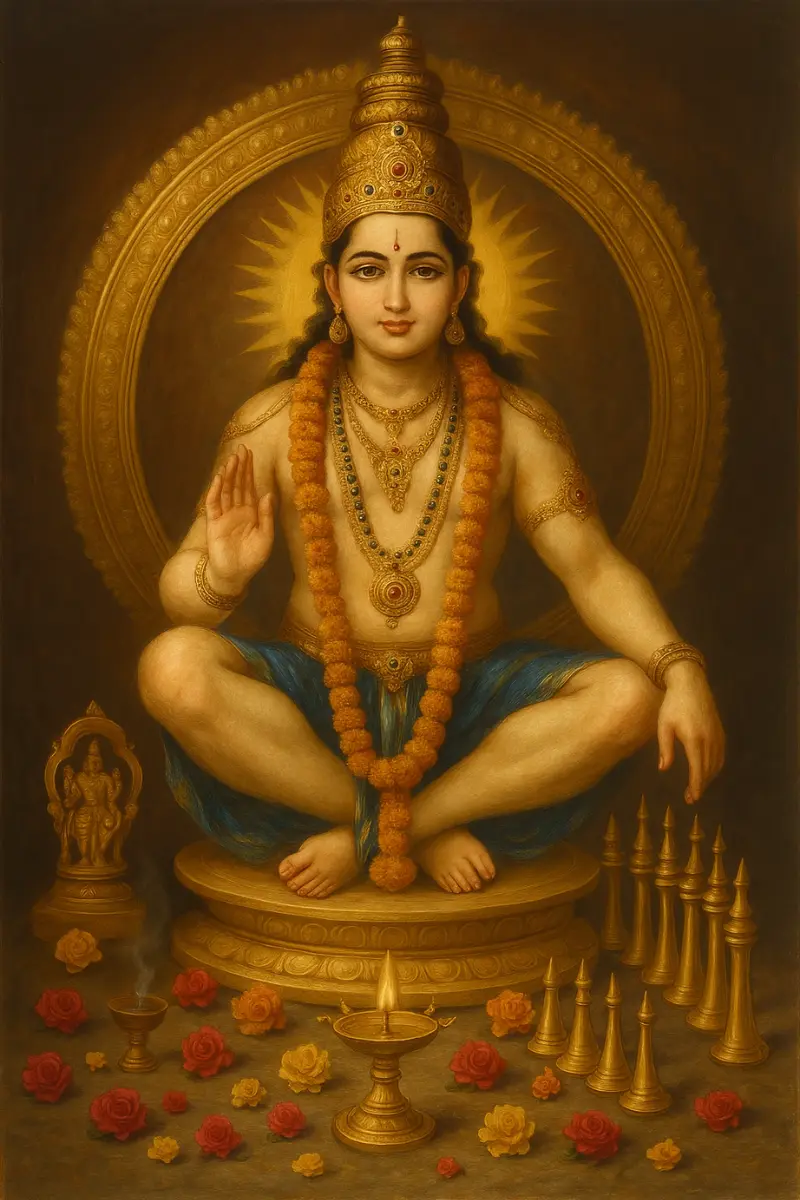
By chanting His mantra, devotees align themselves with his powerful masculine qualities of perfect Brahmacharya and steadfastness in following Dharma. Regular chanting helps devotees cultivate inner peace and spiritual clarity. The mantra acts as a shield against negative influences, allowing you to walk through life with greater focus and positivity.
The Ayyappa Mantra Protects us from Negative Energies
The Ayyappa Mantra serves as a powerful protective shield for those who chant it with devotion, especially the ones who have visited the holy land of Sabarimala and spent time with the ardent devotees of the Lord and heard His pastimes from the Guru Swami, or primary devotee who has lead many other devotees to Sabarimala, as is the custom in the southern parts of Bharat. It is believed that chanting the mantra creates a barrier against negative energies and evil forces.
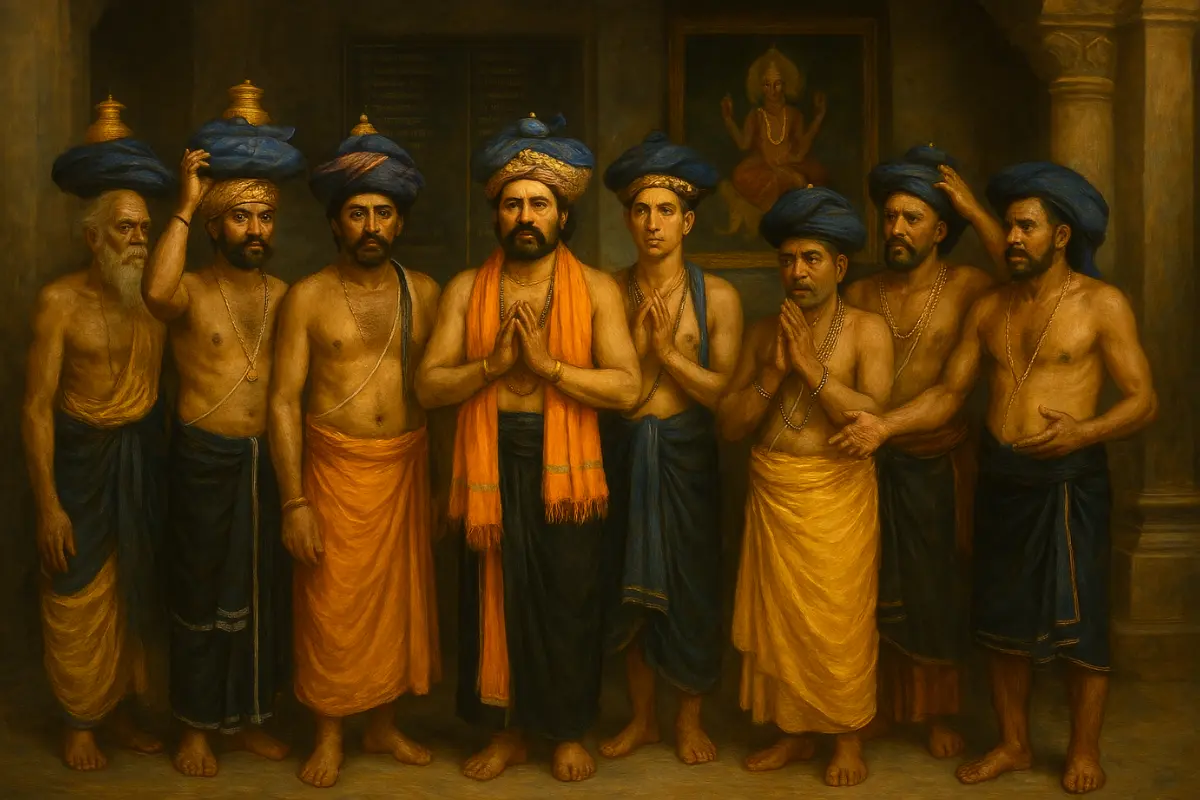
The sacred syllables of the mantra have vibrations that invoke the Grace of Lord Ayyappa, reviving his thoughts in the mind that have the ability to possess the chanter with complete Grace and protection that harmonize with the energies of the universe, building an impregnable armour around the devotee.. Those who chant the Ayyappa Mantra regularly feel a heightened sense of safety and protection, both spiritually and physically. Many devotees have reported feeling shielded from harm, negativity, and malicious intentions. This is especially true when the devotee is totally surrendered to Ayyappa Swamy.
Lord Ayyappa and Enhancement of Devotion and Faith
The Ayyappa Mantra deepens one’s devotion and strengthens the bond with the divine. It reminds the chanter of the higher spiritual purpose of life and takes one beyond the lower tendencies of lust. Visiting Sabarimala during the holy months mentioned above is a must, if one wants to explore the total power of the Ayyappa manthiram.
Through its rhythmic chanting, the mantra creates a direct connection to Lord Ayyappa, who is said to be physically present with the sincere surrendered devotee. This strengthens the devotee’s resolve and dedication towards spiritual practices such as meditation, prayer, and Seva. Many devotees have shared how their faith has been transformed, with the mantra providing them with the courage and strength to face life’s challenges.
The Ayyappa Mantra and Devotee Association for Healing and Stress Relief
The Ayyappa Mantra is a divine tool for healing both the mind and body.Practitioners of the clarion call to Lord Ayyappa who visit the Sabarimala Dhama are special individuals who have special past life bonding with the great deity.

There is no question about this. Such devotees have a unique power of giving others their associations and helping weaker ones alleviate stress, anxiety, and emotional disturbances. The repetitive chanting of the mantra under a staunch devotee of Lord Ayyappa can give tremendous power to the chanter and the mantra helps calm the nervous system, lowering stress levels and promoting emotional well-being.
The association of devotees of Ayyappa Swamy helps activate the parasympathetic nervous system, helping to reduce feelings of anxiety and fear. Devotees often experience a sense of emotional release and healing as they associate with powerful devotees and chant thus promoting overall well-being. This makes the mantra especially received from exalted devotees of Lord Ayyappa, powerful during times of emotional turmoil or physical illness.
Divine Blessings of Prosperity and Success
Lord Ayyappa is also known for bestowing unparalleled blessings of prosperity, success, and fulfillment. Chanting His mantra can bring abundance in various forms, be it in health, career, relationships, or material wealth. The Ayyappa Mantra aligns the devotee’s intention with the divine will, helping to manifest positive outcomes in life. Devotees believe that Lord Ayyappa’s blessings flow in many unexpected ways once the mantra is sincerely chanted. Numerous devotees have experienced unexpected gains, career success, and the resolution of long-standing challenges and resolution of lawsuits after consistently chanting the Ayyappa Mantra.
Who is Lord Ayyappa
Sri Ayyappa Swamy is no ordinary deity. His divine birth is rooted in the union of Lord Shiva and Mohini, the enchanting female form of Lord Vishnu. This rare union of the cosmic masculine and feminine energies resulted in the birth of Manikandan. The name of the deity came about because of the shining Mani (gem) tied around his neck when he was discovered as an infant. This symbolic birth is of immense Vedic significance. It represents the integration of Bhagawan Shiva’s tapas (spiritual austerity) and Lord Vishnu’s maya (divine illusion), bringing forth a divine child destined to restore dharma.
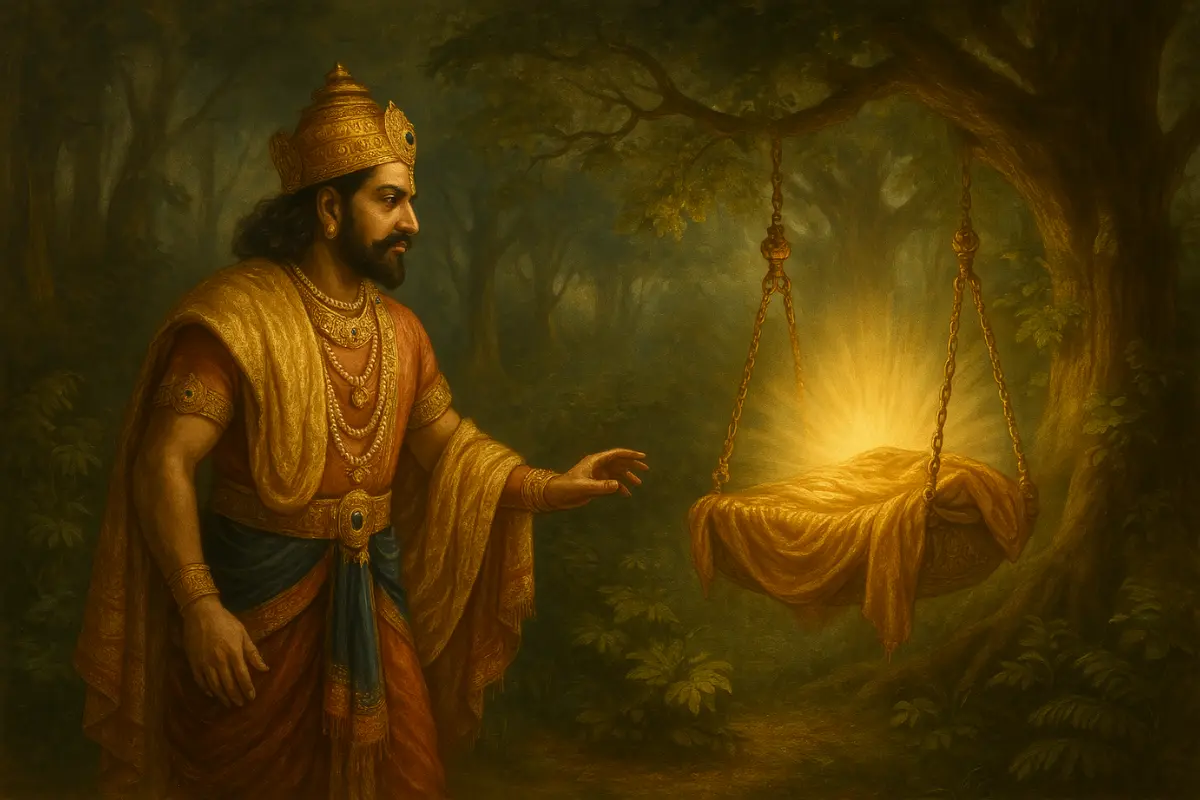
The legend of Lord Ayyappa’s earthly arrival is beautifully narrated in the Bhutanatha Upakhyana and Lalitopakhyana sections of the Brahmanda Purana. The king of Pandalam, Rajasekhara, discovered the infant Manikandan on the banks of the Pampa River. Childless and pious, the king accepted the divine child as his own. As the boy grew, his divine aura became evident. He mastered the Vedas, scriptures, and martial arts, outshining even the wisest of scholars and bravest of warriors.
One of the most awe-inspiring episodes from Ayyappa Swamy’s life is the story of how Lord Ayyappa rode a tigress. In order to fulfill the wish of the queen who demanded tiger’s milk as a cure for her illness, the young Manikandan ventured into the forest. While all expected his death, he returned triumphantly riding a tigress, followed by a herd of wild tigers. This miraculous event confirmed His divine nature and established Him as an incarnation with a cosmic mission.
Other Scriptures Speak About Lord Ayyappa
The Bhavishya Purana and the Sthala Purana of Sabarimala also narrate Lord Ayyappa’s valor in defeating the demoness Mahishi. Mahishi, born of a boon and immune to death by any being except the son of Shiva and Vishnu, wreaked havoc on earth and heavens. It was Sri Ayyappa who fulfilled the cosmic prophecy by vanquishing her, bringing peace back to the world.
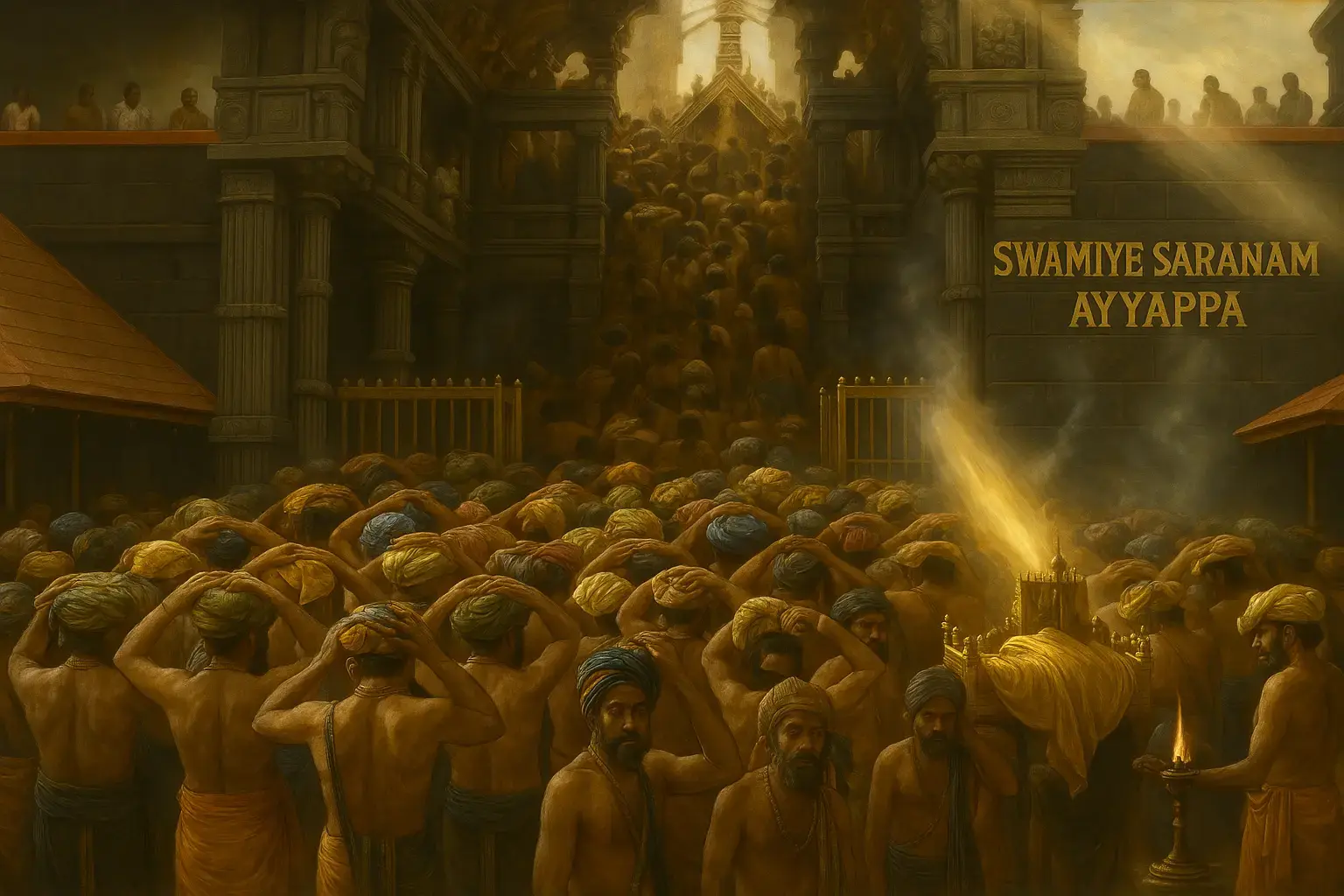
The location of this triumph, the serene and sacred hill of Sabarimala, became His eternal abode. The Sthala Purana of Sabarimala tells how, after fulfilling His divine mission, Lord Ayyappa entered into deep meditation atop the hill. The temple stands as a beacon of purity and discipline, attracting millions of pilgrims each year.
Sabarimala and the Ayyappa Vratham
Devotees who undertake the sacred pilgrimage to Sabarimala observe a 41-day Vrata, known as Mandala Vratham. This vrata is not just a ritual but a spiritual preparation. The devotee renounces worldly pleasures, wears black or blue garments, observes celibacy, practices simplicity, and focuses on sadhana. This process of inner purification prepares the seeker to ascend the 18 sacred steps of Sabarimala and have darshan of the Lord.
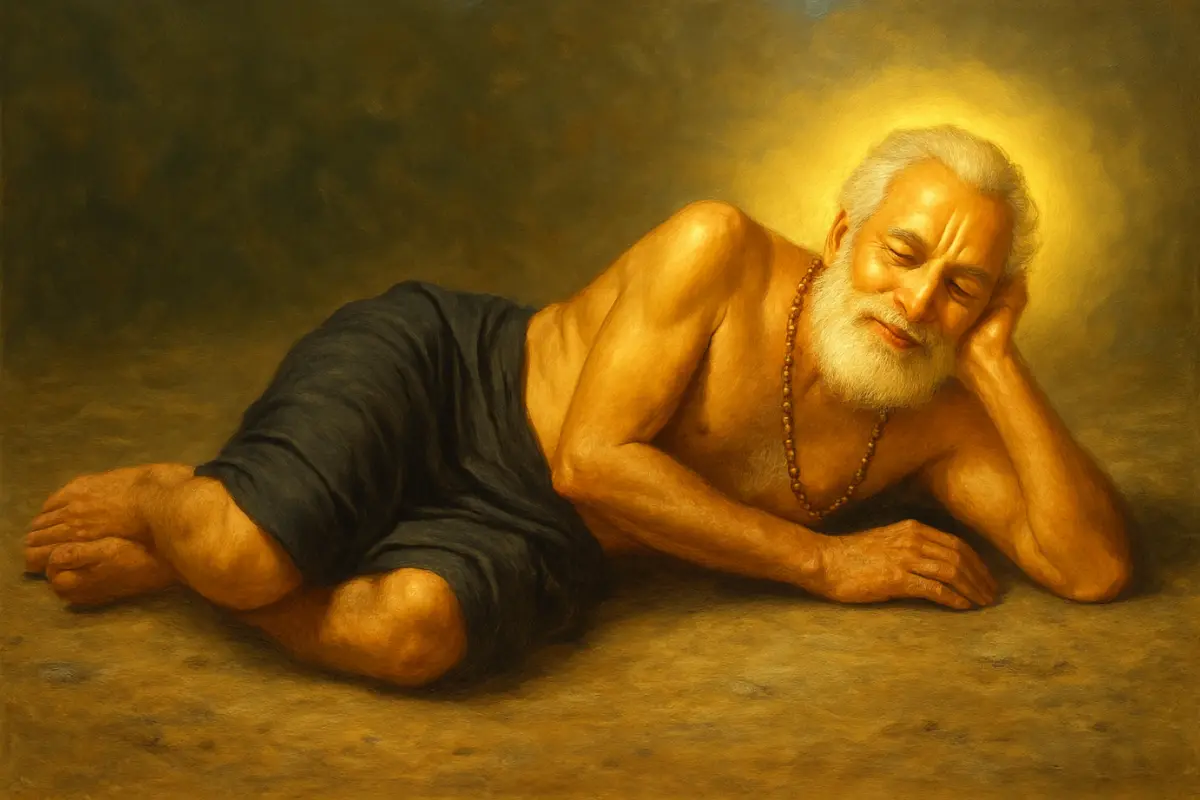
One of the most heart-touching elements in Ayyappa lore is the legend of Malikapurathamma, often seen as the eternal feminine energy associated with Lord Ayyappa. Though Lord Ayyappa is a Naishtika Brahmachari (eternal celibate), Malikapurathamma waits for Him at a nearby shrine. It is said that she had asked for His hand in marriage, and Lord Ayyappa promised to marry her the day no new devotee came to see Him. To this day, the line of pilgrims has never ceased, and Malikapurathamma continues to wait, symbolizing divine longing and eternal love beyond fulfillment.
The Holy Months of Visit to Sabarimala: Tradition, Vrata, and Makaravilakku
The pilgrimage to Sabarimala is one of the most significant and revered journeys undertaken by devotees in South India. The visit is typically observed during two specific periods of the year, namely Mandala (November to December) and Makaravilakku (January), which are the holy months dedicated to Lord Ayyappa.
The Tradition of Guru Swamis and the Vrata
The tradition of the Guru Swami is an essential aspect of the Sabarimala pilgrimage. Guru Swamis are spiritual guides and leaders who lead a group of devotees on their journey to the temple. These revered individuals are responsible for guiding the devotees through the ritualistic practices and spiritual discipline required to complete the pilgrimage. They play a key role in overseeing the 41-day Vrata (fasting and spiritual discipline) that each devotee undertakes before visiting Sabarimala.
The Vrata is a period of intense purification and preparation for the devotee. The 41 days are spent adhering to strict guidelines: maintaining celibacy, avoiding alcohol, and engaging in daily prayers and meditation. Devotees wear black or blue attire, symbolizing simplicity, and often carry a mala (rosary) to help them remain focused on their devotion. The Vrata helps cleanse the mind, body, and spirit, preparing the devotee to ascend the 18 sacred steps (പതിനെട്ടാംപടി) of Sabarimala.
The Pathinettampadi (പതിനെട്ടാംപടി) of Sabarimala.
The Pathinettampadi or Pathinettampadi (18 divine steps) leading to the main sanctum at Sabarimala is an embodiment of divine significance, rich in both spiritual and historical meaning. Each of the steps holds deep symbolism, reflecting various aspects of life and the journey towards self-realization. The first three steps are associated with the four elements, Bhoomi (Earth), Agni (Fire), Vayoo (Air), and Akash (Sky), which represent the fundamental forces that sustain life.
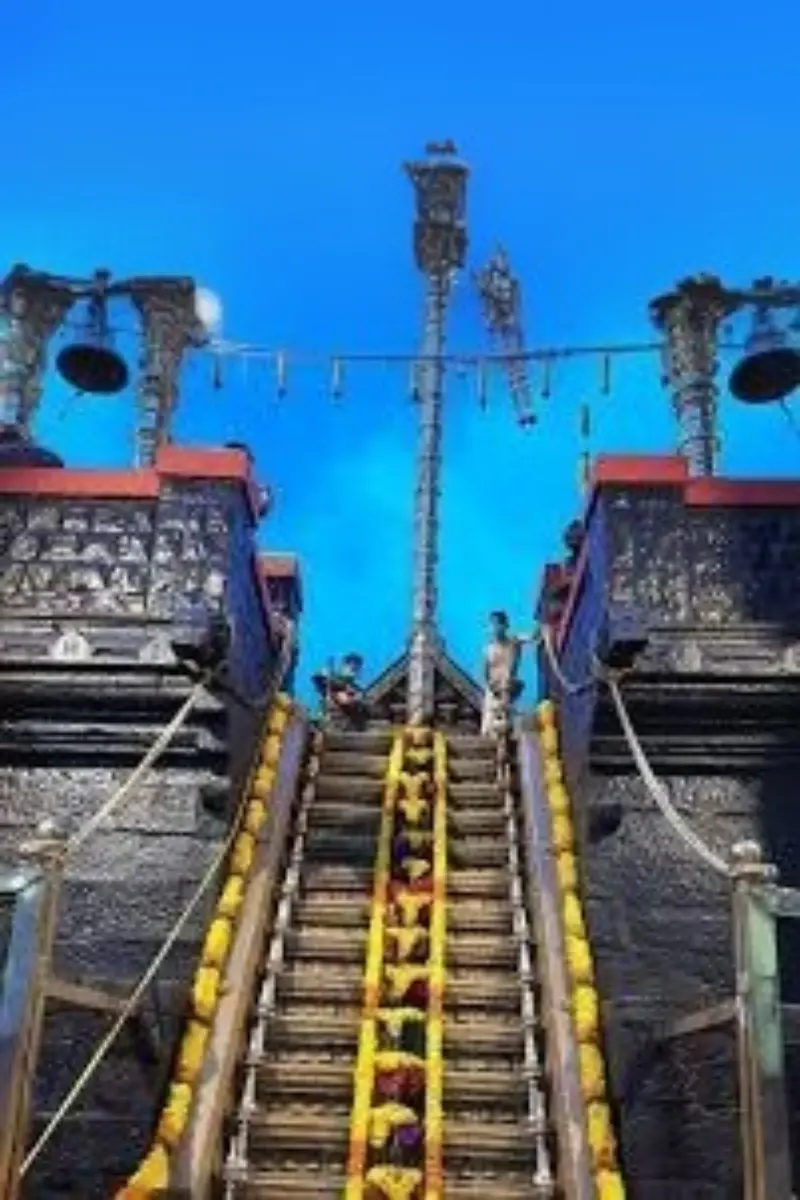
As pilgrims continue their ascent, the steps evolve in their spiritual importance: steps 6 to 9 symbolize the Karmendriya (organs of action), steps 10 to 15 represent the Jnanendriya (organs of perception), the 16th step is dedicated to the Mind, the 17th to Intelligence, and finally, the 18th step signifies the Jeevathma Bhava (the soul’s essence). Crossing these 18 sacred steps is considered a profound accomplishment, bestowing upon the devotee the blessing of Punyadarshanam (പുണ്യദർശനം) a vision of spiritual merit.
The steep steps are not just a physical challenge but a holy journey that requires utmost devotion and discipline. To ascend them, one must observe a 41-day Vrata, a period of fasting, abstinence, and purity, and carry the Irumudi (இருமுடிa sacred bundle) on one’s head. These practices prepare the devotee spiritually for the sacred climb, ensuring that they are mentally and physically ready to meet Lord Ayyappa.
Historically, in Vedic Parlance, there are numerous interpretations of the 18 steps. It is often interpreted that the steps represent the 18 Puranas, while some Acharyas see them as a symbol of the 18 weapons used by Lord Ayyappa to defeat evil forces. A different interpretation connects the steps to the Indriyas (senses), the first five steps represent the five senses: eyes, ears, nose, tongue, and skin.
The next eight steps signify the Ragas (emotions), including Tattwa (The material elements), Kama (Lust), Krodha (Anger), Moha (Illusion), Lobha (Greed), Madha (Self-Pride), Matsarya (Envy), and Ahamkara (ego/I/Me/Mine). The following three steps represent the Gunas (qualities): Satwa (purity), Rajas (passion), and Tamas (ignorance). Finally, the 17th and 18th steps signify Vidhya (knowledge) and Ajnana (ignorance).

The Pathinettampadi can only be used twice by each devotee, once during the ascent to the temple and once during the descent when leaving the hill. Pilgrims often offer a coconut at the steps as a mark of respect and devotion before beginning their climb. When descending, devotees must walk backward, facing the sanctum, maintaining the reverence of the sacred place.
An additional belief is that a devotee who climbs the Pathinettampadi 18 times is required to plant a coconut sapling in Sabarimala, symbolizing the sustenance and continued growth of the pilgrimage.
The Ayyappa Temple, perched atop a plateau about 40 feet high, offers a majestic view of the surrounding mountains and valleys. The temple, though ancient, was rebuilt after a fire in 1950. Inside the sanctum, under a copper-plated roof adorned with four golden finials, rests the idol of Lord Ayyappa, cast in panchaloha (an alloy of five metals). This beautiful idol stands at about one and a half feet tall, surrounded by the serene and sacred atmosphere of the temple. The Mandapams and Belikalpura, which houses the altar and the flag-staff, complete the sacred space, where devotees come to experience the divine presence of Lord Ayyappa.
This sacred temple and its Pathinettampadi are not just a physical journey but a profound spiritual pilgrimage, offering devotees a chance to purify the soul, attain divine wisdom, and experience a deeper connection with Lord Ayyappa.
The Everyday Chart of an Ideal Devotee
The ideal daily routine during the 41-day Vrata is simple but strict. Devotees begin their day early with a bath and lighting of lamps to seek Lord Ayyappa’s blessings. Prayers and the recitation of the Ayyappa Ashtakshara Mantra are integral parts of the morning routine. After prayers, the devotee performs seva (service), which could be anything from helping in the community to performing charity. Throughout the day, the devotee remains focused on their goal of spiritual growth and abstinence from worldly pleasures.
In the evening, devotees perform Arati and offer prayers of thanksgiving. They also reflect on their spiritual journey during the 41 days of Vrata, seeking Lord Ayyappa’s blessings for success, prosperity, and spiritual awakening.
The goals of such Vratas are not intended to be done during festive period or Dhama visits. It is to be established in one’s life permanently for good. Only this can signify a permanent shift in one’s character. Unfortunately, we see modern undertakers of such Vratas in a mood of “being bound” and once their visit to Sabarimala is over they indulge in all the sins they kept themselves away from, signifying that they never did the Vrata in the right mood anyway. This is extremely sad and a sorry state of affairs.
One fails to realize that to be in Vrata is to “experience genuine freedom”, but man’s distorted view paints a completely reverse picture, much against the mood of a genuine spiritual endeavor.
Makaravilakku
Makaravilakku, celebrated in January, marks the conclusion of the Mandala Vrata and is considered the most auspicious day of the pilgrimage. It is a unique tradition wherein devotees gather to witness the Makara Jyothi, a divine celestial light that appears on the horizon near Sabarimala. Many believe this light is a divine signal from Lord Ayyappa, symbolizing his Grace and blessings.
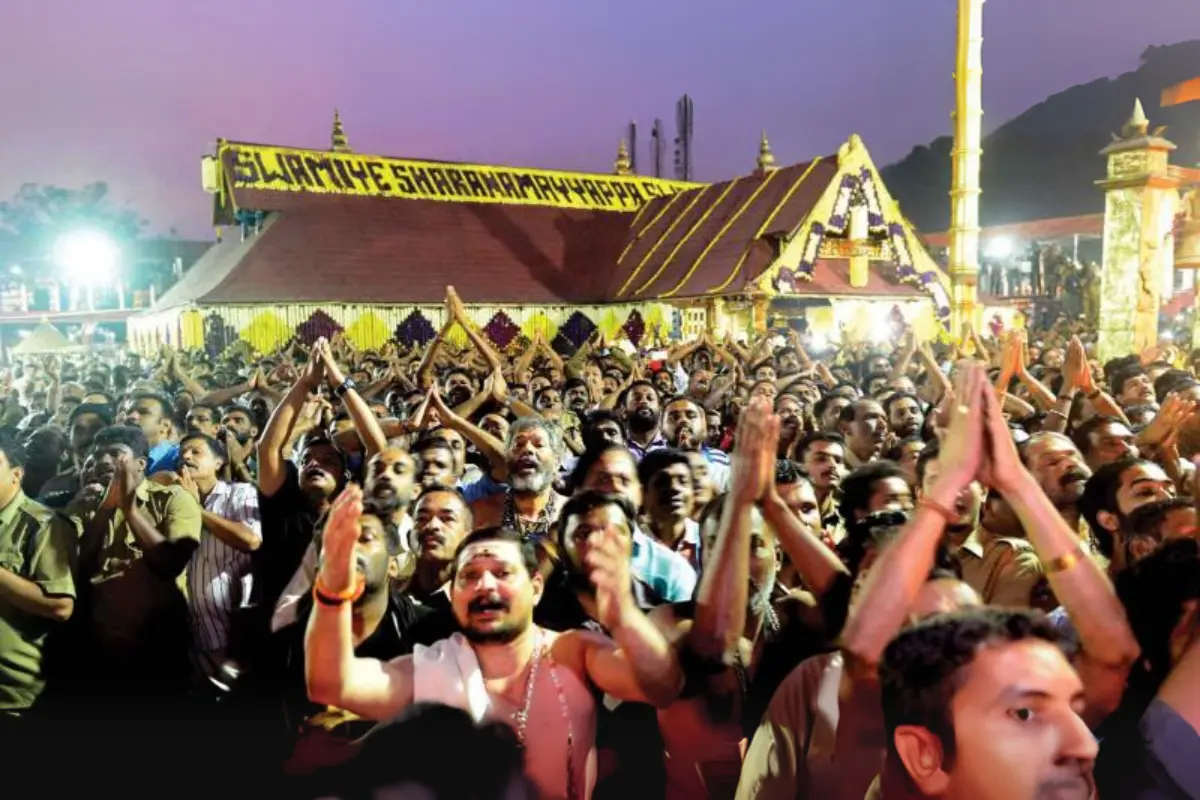
The spectacle of Makaravilakku draws thousands of devotees who gather at Sabarimala to witness the celestial event. During this time, special pujas are conducted, and the entire region is filled with the vibrant energy of devotion and celebration. Makaravilakku is a symbol of hope, divine light, and the triumph of good over evil.
North Bharatiya Devotees
While Sabarimala is predominantly a pilgrimage site for South Indian devotees, it has gained immense popularity across India, attracting a significant number of devotees from North India as well. Pilgrims from various parts of the country, regardless of regional or linguistic differences, make the journey to Sabarimala, drawn by the universal appeal of Lord Ayyappa’s teachings and blessings. The growing number of North Bharatiya devotees underscores the national importance of this sacred journey.
In conclusion, the visit to Sabarimala during the sacred months of Mandala and Makaravilakku is an enriching spiritual experience. The discipline of the Vrata, the guidance of the Guru Swamis, and the magnificent celebration of Makaravilakku make Sabarimala a profound pilgrimage that continues to inspire millions across India, fostering unity, devotion, and spiritual awakening.
Women And Ayyappa Swamy
The restriction on women in their menstruating years (usually between the ages of 10 and 50) from visiting Sabarimala has been a topic of discussion for many years. This restriction, rooted in traditional customs, is deeply tied to the spiritual and symbolic practices associated with the temple and Lord Ayyappa.
At the core of this restriction lies the concept of Lord Ayyappa’s Naishtika Brahmacharya, his vow of eternal celibacy. Lord Ayyappa is believed to embody the ideals of purity, discipline, and asceticism. In this context, the Sabarimala pilgrimage is considered a path of spiritual purification and self-discipline. The restriction on women of menstruating age is viewed as a way to maintain the sanctity of the temple and uphold the principles of celibacy and spiritual purity that Lord Ayyappa exemplifies.
The menstruating phase of a woman’s life is traditionally seen in many cultures as a time of restriction and a period of physical and emotional changes, associated with mood flings and less control on emotional outbursts. In this context, the prohibition is not meant to disrespect women but rather to adhere to the strict spiritual guidelines set by the temple’s traditions, which is ages old and gives the temple its place, for what it deeply signifies.
This rule aligns with the ascetic lifestyle of Lord Ayyappa and serves to maintain the focus on spirituality, purification, and devotion. The transition, was, is and never against the women fold. This is reflected in the mood of the female devotee and eternal lover of Lord Ayyapan, Malikapurathamma who is waiting for Her Lord. How can then the traditions be against women?

The significance of this tradition is not just about physical purity; it is symbolic of the spiritual journey that requires discipline, sacrifice, and focus. The pilgrimage to Sabarimala is seen as a rigorous test of devotion, and many devotees undertake the 41-day Vrata, during which they abstain from worldly pleasures, including celibacy and maintaining physical purity, as a way of preparing for their spiritual encounter with Lord Ayyappa.
However, this restriction has faced legal challenges and debates, particularly in recent years, with questions about gender equality and access to religious spaces. Despite this, the traditional ban remains an integral part of the Sabarimala pilgrimage, emphasizing the importance of ritual purity and spiritual discipline in the pursuit of divine Grace. This can and should never be challenged. Challenging or breaking this rule is like desecrating the spiritual vow of the great Lord, blasphemy of a serious kind.
The Tradition of Sastha Preeti (Shastaa Preethi)
Another notable tradition is the Sastha Preethi, celebrated with immense devotion in Tamil Nadu and Kerala. Sastha Preethi, which means ‘the pleasing of Sastha,’ involves singing bhajans, reciting the Ayyappa Sahasranama, and performing pujas to honor Sri Ayyappa Swami. These gatherings invoke the divine presence and deepen the communal bond among devotees.
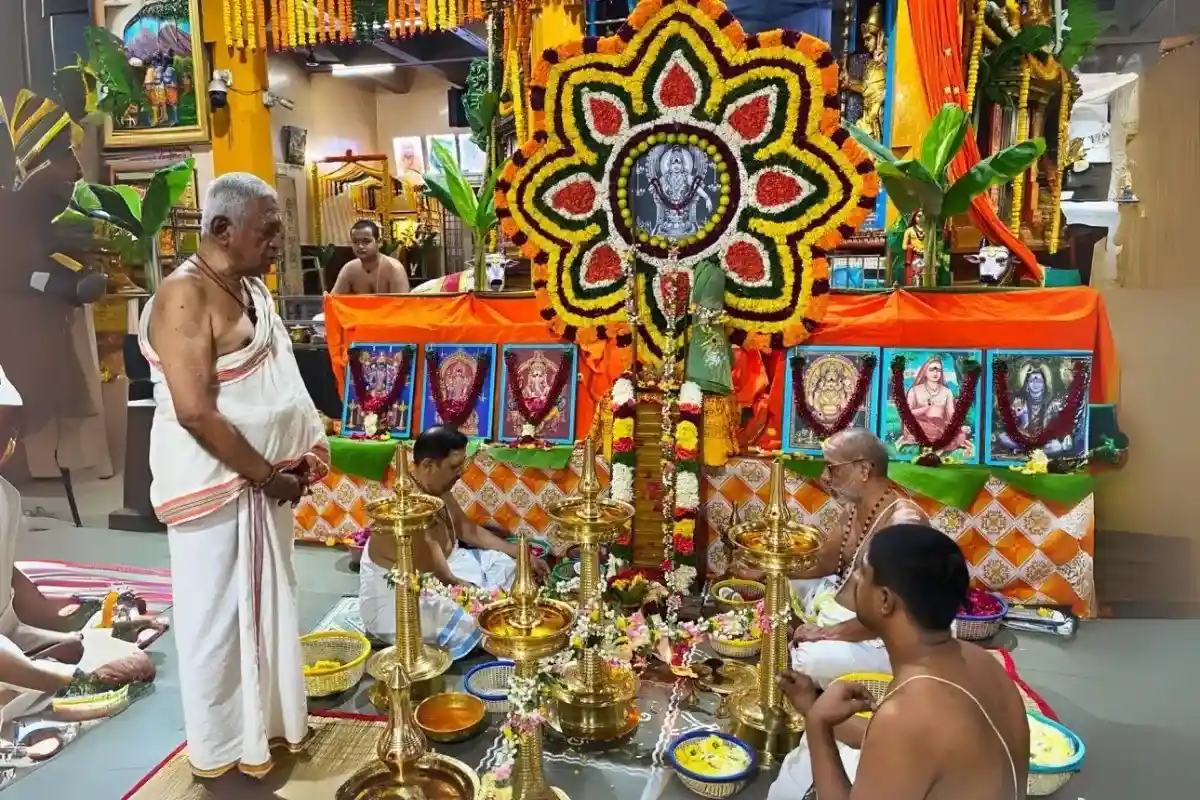
Lord Ayyappa is also known as Dharma Sastha, the one who upholds dharma. His worship unites people beyond caste, creed, and religion. The path to Sabarimala is walked not just by Hindus but by all who seek truth, discipline, and divine grace. His mantra, “Swamiye Sharanam Ayyappa” (സ്വാമിയേ ശരണം അയ്യപ്പ), is a soul call, an invocation of complete surrender. Through this mantra, we relinquish ego, embrace humility, and merge with the divine will.
To chant this mantra is to invite Lord Ayyappa’s divine presence into your life. His blessings purify, protect, uplift, and guide. His story is not just a tale of divine incarnation but a living embodiment of truth, strength, purity, and compassion. May the light of Sri Ayyappa Swami always illuminate your path.
Swamiye Sharanam Ayyappa (സ്വാമിയേ ശരണം അയ്യപ്പ).

